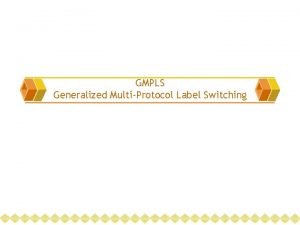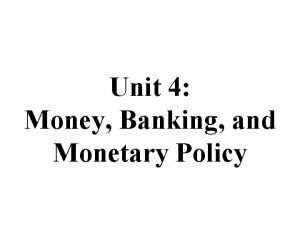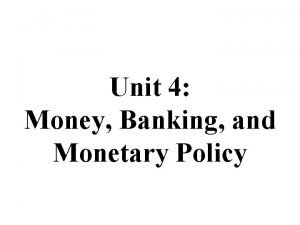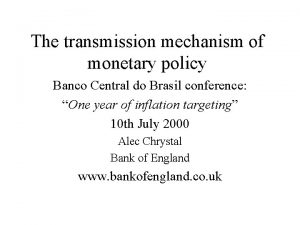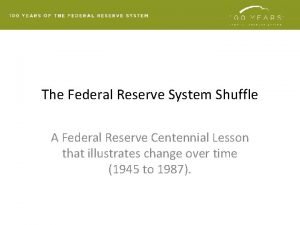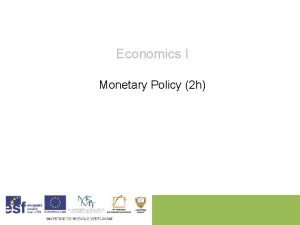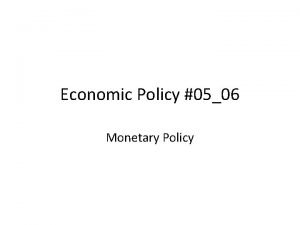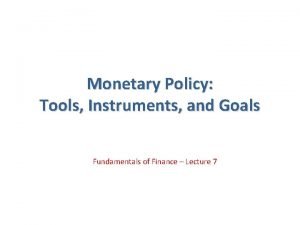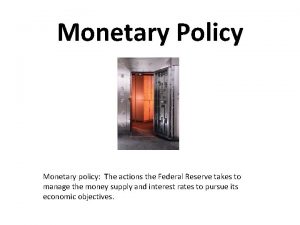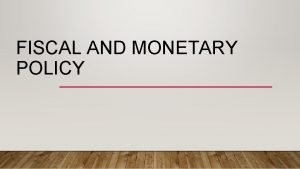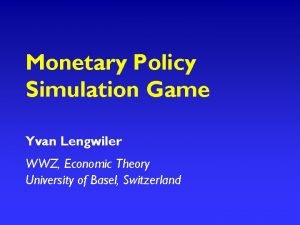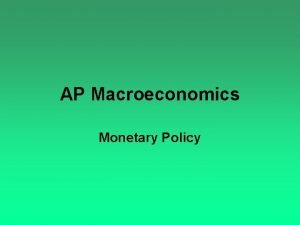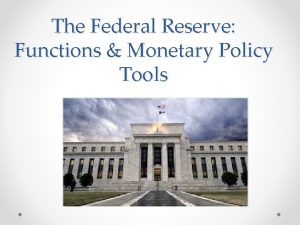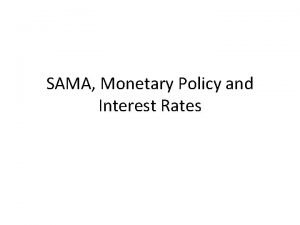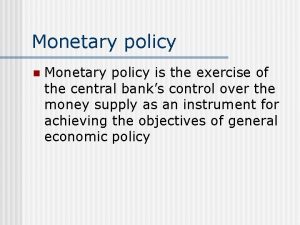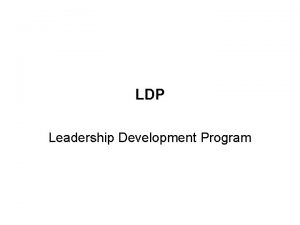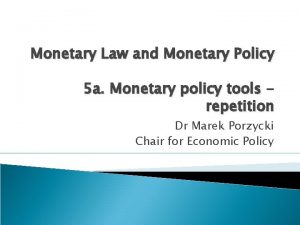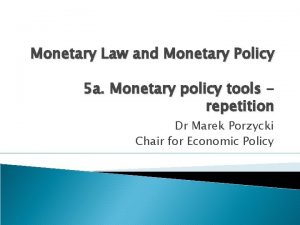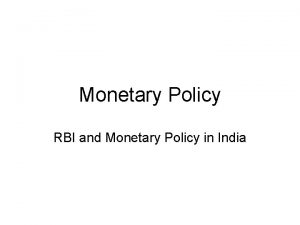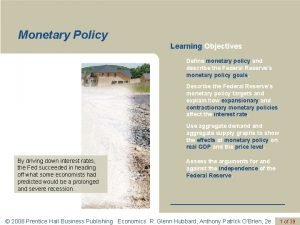Economic Development of Japan LDP Aggressive monetary policy


























- Slides: 26

Economic Development of Japan LDP Aggressive monetary policy Flexible fiscal policy New growth strategy No. 13 Abenomics

Deterioration of Japanese Politics? Koizumi 2001 -2006 Liberal Democratic Party (LDP) 1955 -2009, 2012(except 1993 -96) Democratic Party of Japan (DPJ) 2009 -2012 LDP Abe No. 2 2012 - • Between Koizumi and Abe 2, there were six PMs in 6 years. • LDP (Abe, Fukuda, Aso: 2006 -09) was unpopular leading to the change of government to DPJ in August 2009. • DPJ (Hatoyama, Kan, Noda: 2009 -2012) proved even worse than LDP; random policies and amateur politics. • Transition from “ 1955 Regime” (LDP’s political dominance) to alternating two-party competition was not realized. • Abe 2: win popularity with Abenomics, then push defense-related conservative agenda (Article 9 of Constitution, SDF, Okinawa)

Second Government of Shinzo Abe p p p First Abe Cabinet (Sep. 2006 -Sep. 2007) was unsuccessful. Second Abe Cabinet (Dec. 2012 -2021? ) has the following features: n Active, quick, and vigorous (compared with past PMs). n Politically conservative (critiques say “right wing”): promoting business interests, active defense policy. n Revising the Constitution (adding to Article 9)—instilling nationalism, more military possibilities. n Diplomatically active (foreign visits, top sales, coping with China, etc. )—but promises are not properly followed up. n Abenomics for ending deflation and reviving growth. High popularity + weak oppositions = LDP’s free hand Economic recovery is welcomed by businesses & people With gained popularity, Abe wants to push his “right wing” agenda—but they are not so popular among people.

Dominance of LDP-Komei Coalition Ruling party coalition has majority in both Houses due to weak & fragmented opposition; it can force any law after debating it formally & superficially in the parliament. The term of The House of Representatives is four years; last election took place in Dec. 2014. The term of The House of Councillors is six years with half elected every three years; last election took place in July 2016.

Three Arrows of Abenomics To revive the economy, three “arrows” are mobilized. 1. Aggressive monetary policy (“New Dimension”) - PM Abe appoints BOJ Governor Haruhiko Kuroda (Mar. 2013) - Dispel deflation mindset: inflation target of 2% within 2 years - Monetary expansion with new asset purchases (REIT, etc. ); doubling monetary base & gov’t bond holding in 2 years - Correction of high yen (done, or overdone) 2. Flexible (=active) fiscal policy - Revive economy first, consolidate budget later - Increase infrastructure investment 3. New growth strategy (cabinet approval in June 2013; another cabinet decision in June 2014; another in June 2015) - Japanese Economy Revitalization Headquarters (under it: Industrial Competitiveness Conference) - 3 roadmaps and 3 plans (12 pillars – 37 items – 56 sub-items); with later revisions & additions

Source: Japan Revitalization Headquarters, PM Office





Supporters of Abenomics (2013) J. Stiglitz—“Depreciating yen to end deflation is the right policy. Just as I recommended 10 years ago. ” Paul Krugman—“I evaluate Abenomics highly; no other country could do this policy mix. ” IMF Managing Director Lagarde—”Inflation target of 2% is desirable as long as central bank independence is secured. ” Fed Chairman Bernanke—“I support it as a policy to end deflation. ” Prof. Heizo Takenaka (Keio Univ. )— “Abenomics is 100% right. ” Prof. Koichi Hamada (Abe’s advisor)— “Don’t worry about recent stock market drops—they are just corrections of excess optimism. The real economy is improving. ” Prof. Takatoshi Ito (GRIPS)— “BOJ economists think QE is ineffective. But many researchers and officials support QE as a tool to change inflation expectation. ”

Critiques of Abenomics (2013) George Soros (investment guru)—”Japan’s monetary policy is bold but very risky; it may trigger a collapsing yen. ” Prof. Kunio Okina (Kyoto Univ. )— “If deflation mind is dispelled but fiscal discipline is not secured, monetization of fiscal deficit will generate a serious dilemma between financial stability and price stability. ” Kazuo Ueda (Tokyo Univ. )—Monetary expansion increased interest & yen volatility. If long-term interest rates rise, expected positive impact on real economy will not happen. Ryutaro Kono (BNP Paribas)— “The monetary transmission mechanism is broken. Under such circumstances, monetary expansion may destabilize asset prices, raise long-term interest rates, and put BOJ in a macro policy dilemma. ” Nikkei Newspaper commentary—“The growth strategy lists only easy measures; bold reforms in such key areas as medical service, agriculture, corporate tax rates, etc. are not clarified. ”

Call rate (interbank shortterm interest rate) Money & bank lending Excess reserves are built up at commercial banks during zero interest rate periods Bubble Zero interest rate policy Zero/negative interest rate policy Lehman Shock

My View on Abenomics (2013) p p p Compared with DPJ’s total impotence, Abe is doing much better. He has brightened Japan’s short-term psychology— but that is not enough for long-term growth. A policy mix of fiscal, monetary, and growth policy is nothing new; but Abe’s policy presentation is innovative. Growth policy is central, while fiscal & monetary policies are supplementary. New industries must emerge, then macro policies should support them. Abenomics is strong in fiscal & monetary areas, but growth policy remains weak & random. If long-term interest rates start rising, government will be completely bankrupt. Pumping money into a broken transmission mechanism risks asset bubbles and financial instability. Market psychology is unpredictable and BOJ cannot control what will happen. Proper policy procedure is not followed: there is a disconnect between visions and listed actions.

Pumping money into an integrated world is risky. Global and national good & asset markets Inflation target of 2% Bank of Japan Aggressive monetary policy Global & national liquidity glut General goods & services Consumer durables Government bonds Quantitative expansions US & EU (US Fed: trying to end QE 3 gradually) Foreign money & assets (F/X instability) Driven by unstable market psychology; unpredictable direction & timing Energy & commodities Precious metals Investment in emerging markets Real estate & REIT Stock market

Standard Policy Making Procedure (Five Necessary Conditions) The entire process should take about 1 year for policy revision and 2 -3 years for new policy 5. A secretariat with sufficient authority and responsibility to coordinate the entire process Top leader 1. Vision 2. Consensus building 3. Documentation Brainstorming Studies & surveys Set broad goals & direction Drafting work Comments & revisions (Drafting may be outsourced) Stakeholder consultation 4. Substantive stakeholder participation Ministries &agencies Businesses Academics & consultants Regions & localities Finalize & approve

Growth Strategy in Abenomics p p Broad visions are given (three arrows, three plans, etc. ) but they are not new—contents are basically the same as past ideas of previous governments. Concrete growth measures were presented too quickly without deep consultation with stakeholders. They are just a collection of various ideas proposed by committee members and officials in charge. Visions – (targets) – (policy areas) – random actions? Growth Strategy is a loose wish list, not an action plan. Easy ones are implemented first without specifying required results, timing, budgeting, etc. Because the list is broad & unsurprising, it can cover almost any policy. A special budget of 3 trillion yen was announced in July 2014; another 4 trillion yen in July 2015. Ministries try to get new funding by proposing something seemingly related to Growth Strategy. But this may worsen the scattered and passing nature of Abenomics Growth Strategy.

Growth Strategy in the Second Year: “Implementation Stage” (2014) p p Cabinet approved 124 -page “New” Growth Strategy (June 24, 2014) but it is still a wish list of ideas without consultation or action plans. PM Abe now declares an implementation stage. Added policy areas: n Recovering an earning power—corporate tax cut (to 29%? welcomed by businesses); corporate governance; tripartite convention; investing pension funds in equity market n Producing workforce—demographic targets; childcare facilities; reform tax deductions; mobilizing foreign trainees and domestic workers n Reform rock-solid regulations—revise work rules; medical reform; organizational reform in agriculture n Energy—restart nuclear power, electricity reform, etc. n Tourism—easing visa requirements for ASEAN people, etc.

Comments (2014) Prof. Heizo Takenaka (Keio Univ. )— “New Growth Strategy is better received abroad than a year ago. ” Japan Economic Journal (June 30, 2014)— “This is the 9 th Growth Strategy of the Japanese government since 2001. None of the past Strategies produced results. Their contents were more or less similar: job creation, special zones, creating demand for environmental or medical industries, hiring young workers, etc. Short-lived governments had little time to work on policies. Subsidies were usually wasted. Ministries were happy to report new spending, but there was no monitoring of effectiveness. Unproductive policies must be ended. Money and policy must be directed to fewer programs. ”

Abenomics in the Third Year: “Stage Two” (2015) Cabinet approved “Revised Japan Revitalization Strategy 2015” in June 2015. PM Abe on June 24: “The economic virtuous circle that emerged this year [rising profits & wages] should not be aborted. We must continue this momentum to revive all micro, small & medium enterprises. We must deliver the fruits of economic recovery all over Japan. That is the mission of Abenomics, and all hinges on the implementation of Growth Strategy. Today, we boldly strengthened Growth Strategy. ” Note: critiques say Abenomics has benefited large firms & stock investors, but has not reached SMEs or rural areas; income gaps are widening.

We Are in “Abenomics Stage 2” (Source: PM Office homepage, June 2015) PART I--Productivity revolution through investment for future 1. Promote investment & earning power 1/ Further corporate governance reform—productive dialogue with shareholders, corporate tax reform, public-private dialogue 2/ Innovation ventures—create Japanese Silicon Valley, competition among universities 3/ High-quality infrastructure for Asia and other growth markets 2. Accelerate new-age challenge (4 th Industrial Revolution) Io. T, big data, artificial intelligence, cyber security, My Number system 3. Strengthen potential of individuals Reduce working hours, use female & aged labor, customized career development, new TVET institutions

“Abenomics Stage 2” (cont. ) PART II—Local Abenomics Absolutely increase earning power of medium, small & micro enterprises; effective publicizing of support measures Activate and increase productivity of service sector: local bank support, productivity movement through PPP, use of IT, business benchmarking Mainstreaming agriculture & fishery, medical & age care, tourism PART III—Reform 2020: PPP projects for growth Auto-drive car, hydrogen society, frontline robots, tourism management, inward FDI No methodological change, only minor content change & addition from the first year. It is an average, not spectacular, reform effort. - Too many flashy words with no concrete targets, medium-term action plans… - Still a random wish list with annual modification (“flexible revision”) - Ministries have incentives to propose projects listed in Growth Strategy & Annual Budget Guideline without scrutinizing effectiveness or necessity.

Abenomics in the Fourth Year (2016) “ 100 Million Total Success” (一億総活躍) More Abenomics Needed to Overcome difficulties “New risks for the Japanese economy are slow growth of emerging and developing economies and the Kumamoto Earthquake. In the worst case, Japan may go back to a long deflation. We need to rev up the Abenomics engine to the fullest to overcome these risks. ” (PM Abe, June 1, 2016) GDP 500 600 trillion yen by 2021 New Growth Industries - Io. T, Big Data, AI (30 trillion) - Health, energy, sports, housing (38. 5 trillion) Local Abenomics - Service, SME, agro export, tourism (83. 4 trillion) Production revolution (18. 6 trillion) Innovation HR Overseas market (37. 1 trillion) Use of reform momentum

Abenomics in the Fifth Year (2017) “Toward Society 5. 0” 1. 2. 3. 4. 5. Healthy life and longevity Mobility revolution Next generation of supply chain Comfortable infrastructure and cities Fin. Tech It is now clear that Abenomics growth strategy is revised every year with new slogans, rephrasing and additions without achieving any long-term goals. Criticism and disappointments are rising: “The fifth Basic Policies and Growth Strategy under the current Abe administration have been approved. Abenomics achieved high stock prices and labor shortage, but potential growth remains low. The growth engine is below capacity, and the government’s slogan of Economy First seems remote. ” (Nikkei Newspaper, June 10, 2017)

2% Inflation Target to Be Missed Consumer price index (%/year) Abenomics Source: Bank of Japan Monthly Statistics. p The Bank of Japan alone cannot determine inflation. Actual consumer inflation (all items) was +2. 7% (2014), +0. 8% (2015) and -0. 1% (2016) missing the 2 percent target by a wide margin. p BOJ extended the target beyond the second year, shifted from zero to negative interest rate policy, introduced a policy rule centered on long-term interest rates, then finally admitted that 2 percent inflation might be unrealistic for some time to come. p Low inflation is blamed on the declining global oil price (which is actually good for the Japanese economy), the negative impact of (modest) consumption tax increase and uncertainty surrounding the growth potential of emerging economies.

Budget Improves as Revenues Rise p p p Strong profit pushes up corporate income tax receipt. Consumption tax raised from 5% to 8% (April 2014). Government leans toward more spending than fiscal consolidation. Level of dependence on JGBs = Borrowing _____ Borrowing+Fiscal revenue
 Prefix
Prefix Ldp lsp
Ldp lsp Splg kpm individu
Splg kpm individu Background
Background Babcock ldp cpd
Babcock ldp cpd Unit 4 money banking and monetary policy
Unit 4 money banking and monetary policy Unit 4 money banking and monetary policy
Unit 4 money banking and monetary policy Transmission mechanism
Transmission mechanism Lesson quiz 16-1 monetary policy
Lesson quiz 16-1 monetary policy Meaning of monetary
Meaning of monetary What is the meaning of monetary policy
What is the meaning of monetary policy Types of monetary policy
Types of monetary policy Fiscal policy effect on interest rates
Fiscal policy effect on interest rates What are the objectives of monetary policy
What are the objectives of monetary policy Objectives of monetary policy
Objectives of monetary policy Contractionary monetary policies
Contractionary monetary policies Three tools of monetary policy
Three tools of monetary policy Monetary policy summary
Monetary policy summary Fiscal vs monetary policy
Fiscal vs monetary policy Monetary policy simulation game
Monetary policy simulation game Types of monetary policy
Types of monetary policy Instruments of monetary policy
Instruments of monetary policy Fiscal policy to control inflation
Fiscal policy to control inflation Moral suasion in monetary policy
Moral suasion in monetary policy Ano ang tight money policy
Ano ang tight money policy Sama exchange rate
Sama exchange rate Instruments of monetary policy
Instruments of monetary policy

